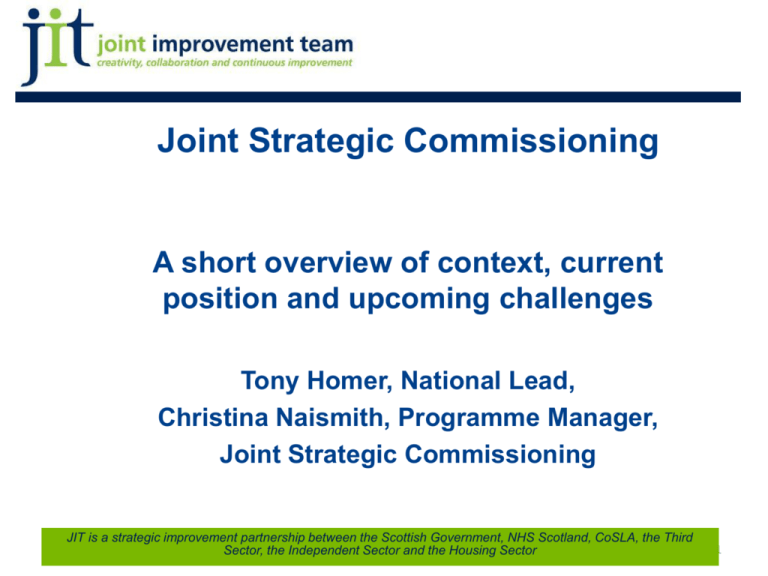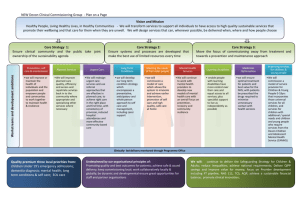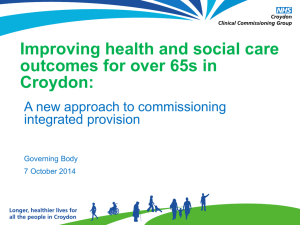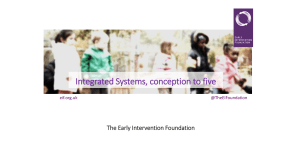Joint-Strategic-Commissioning
advertisement

Joint Strategic Commissioning A short overview of context, current position and upcoming challenges Tony Homer, National Lead, Christina Naismith, Programme Manager, Joint Strategic Commissioning JIT is a strategic improvement partnership between the Scottish Government, NHS Scotland, CoSLA, the Third Sector, the Independent Sector and the Housing Sector 1 Key Drivers for Change 2 Demand Money Innovation Quality Law Political Co-production Tackling Inequalities Key National Drivers Public Bodies (Joint Working) (Scotland) Bill 2013 Social Care (Self-directed Support) Act 2013 Community Empowerment (Scotland) Bill Human Rights (SNAP) Community Planning & SOAs Reshaping Care for Older People National Legislation & Strategies inc Criminal Justice, Learning Disability Children & Young People’s Bill EU Procurement Directives Procurement Reform Activity The Commissioning Cycle JIT is a strategic improvement partnership between the Scottish Government , NHS Scotland, CoSLA, the Third Sector, the Independent Sector and the Housing Sector 4 Lessons from the Older People’s Change Fund • • • • • • • Strong local leadership A cross sector co-production approach Local governance arrangements Effective use of information and evidence Consistent use of robust option appraisal approaches Mainstreaming small tests of change Ensuring effective linkage between commissioning and procurement Legislative Requirements • The Public Bodies ( Joint Working) (Scotland) Bill requires that the new integrated health and social care partnerships will oversee the development and delivery of the Strategic Plans, (Joint Strategic Commissioning Plans) • Strategic Plans, (Joint Strategic Commissioning Plans), which incorporate a Financial Plan, will be required for all adult care groups by April 2015 • 1. Establish a Strategic Planning Group for the purpose of preparing a Strategic Plan • 2. Establish at least 2 locality areas to drive a ‘bottom up’ planning focus • 3. Take into account the plans of neighbouring areas and the possible impact of the plan on other plans and planning activity 1. Strategic Planning Group • Purpose is to prepare a Strategic Plan and to maintain an ongoing role in reviewing and improving the Strategic Plan • Membership will include: – People who use services and unpaid carers – Third and independent sector providers, representative organisations and advocacy groups – Local authority and Health Board nominees – Social work and social care professionals – GPs, clinicians, nurses, AHPs and other professional groups – Housing representatives – A representative from each locality planning group – Staff side and/or trade union representatives 2. The Role of Localities To feed into the strategic commissioning process a collective view on what needs to be made available in respect of their locality On an on-going basis decide on proposals from local professionals, users and communities on ways to improve the delivery of services for the locality. In time, greater responsibility over financial & service planning, changes and decision making. 3. Levels of commissioning; National Regional Sub-regional Strategic Locality 9 Individual Challenges for the future • Commissioning for outcomes • From OP to all adult care groups and beyond • Making the most of locality arrangements • Providers as ‘strategic partners’ • Enabling national vol orgs to engage effectively • Different players and different relationships • Enabling the ‘individual commissioner’ JIT is a strategic improvement partnership between the Scottish Government, NHS Scotland, CoSLA, the Third Sector, the Independent Sector and the Housing Sector 10







